
Woodworm is the wood-eating larvae of many species of beetle. It is also a generic description given to the infestation of a wooden item by these larvae.

The emerald ash borer is a green buprestid or jewel beetle native to north-eastern Asia that feeds on ash species. Females lay eggs in bark crevices on ash trees, and larvae feed underneath the bark of ash trees to emerge as adults in one to two years. In its native range, it is typically found at low densities and does not cause significant damage to trees native to the area. Outside its native range, it is an invasive species and is highly destructive to ash trees native to northwest Europe and North America. Prior to being found in North America, very little was known about emerald ash borer in its native range; this has resulted in much of the research on its biology being focused in North America. Local governments in North America are attempting to control it by monitoring its spread, diversifying tree species, insecticides, and biological control.

A bark beetle is one of about 220 genera with 6,000 species of beetles in the subfamily Scolytinae. Traditionally, this was considered a distinct family Scolytidae, but is now understood to be very specialized members of the "true weevil" family (Curculionidae). Well-known species are members of the type genus Scolytus, namely the European elm bark beetle S. multistriatus and the large elm bark beetle S. scolytus, which like the American elm bark beetle Hylurgopinus rufipes, transmit Dutch elm disease fungi (Ophiostoma). The mountain pine beetle Dendroctonus ponderosae, southern pine beetle Dendroctonus frontalis, and their near relatives are major pests of conifer forests in North America. A similarly aggressive species in Europe is the spruce ips Ips typographus. A tiny bark beetle, the coffee berry borer, Hypothenemus hampei is a major pest on coffee plantations around the world.

The common furniture beetle or common house borer is a woodboring beetle. In the larval stage it bores in wood and feeds upon it. Adult Anobium punctatum measure 2.7–4.5 millimetres (0.11–0.18 in) in length. They have brown ellipsoidal bodies with a prothorax resembling a monk's cowl .
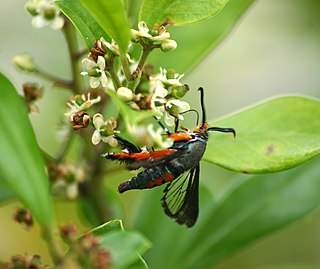
The squash vine borer is a diurnal species of sesiid moth. It is native to North America. The moth is often mistaken for a bee or wasp because of its movements, and the bright orange hindleg scales. The females typically lay their eggs at the base of leaf stalks, and the caterpillars develop and feed inside the stalk, eventually killing the leaf. They soon migrate to the main stem, and with enough feeding damage to the stem, the entire plant may die. For this reason, it is considered a pest that attacks cultivated varieties of squash.

The term woodboring beetle encompasses many species and families of beetles whose larval or adult forms eat and destroy wood. In the woodworking industry, larval stages of some are sometimes referred to as woodworms. The three most speciose families of woodboring beetles are longhorn beetles, bark beetles and weevils, and metallic flat-headed borers.
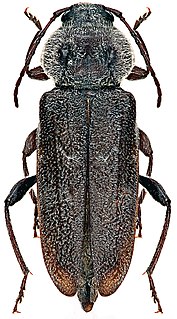
Hylotrupes is a monotypic genus of woodboring beetles in the family Cerambycidae, the longhorn beetles. The sole species, Hylotrupes bajulus, is known by several common names, including house longhorn beetle, old house borer, and European house borer. It is the only genus in the tribe Hylotrupini. Originating in Europe, and having been spread in timber and wood products, the beetle now has a practically cosmopolitan distribution, including Southern Africa, Asia, the Americas, Australia, and much of Europe and the Mediterranean.

Cleridae are a family of beetles of the superfamily Cleroidea. They are commonly known as checkered beetles. The family Cleridae has a worldwide distribution, and a variety of habitats and feeding preferences.
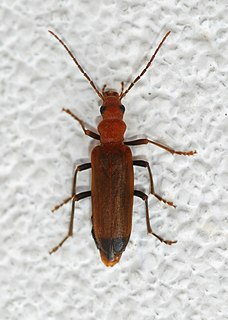
The wharf borer, Nacerdes melanura, belongs to the insect order Coleoptera, the beetles. They belong to the family Oedemeridae, which are commonly known as false blister beetles. Wharf borers are present in all the states of the USA except for Florida. It takes about a year to develop from an egg to an adult. The insect is called the 'wharf borer' because the larval stage of this insect is often found on pilings and timbers of wharves, especially along coastal areas. The adult beetles can be identified via a black band across the end of both elytra, or wing covers. In addition, wharf borers can be distinguished from other members of the family Oedemeridae via the presence of a single spur on the tibia of the forelegs, and the distance between both eyes. Eggs are oviposited on rotten wood where larvae hatch and burrow to feed on rotten wood. Adults do not feed and depend on stored energy reserves accumulated during the larval stage. They are considered to be a pest because they damage wood used in building infrastructures.

The cottonwood borer is a species of longhorn beetle found in the United States east of the Rocky Mountains that feeds on cottonwood trees. It is one of the largest insects in North America, with lengths reaching 40 millimetres (1.6 in) and widths, 12 mm (0.47 in). It is the only species in the genus Plectrodera.

Polyphagozerra coffeae, the red coffee borer or coffee carpenter, is a moth of the family Cossidae. It was described by John Nietner in 1861 and is found in Asia. Records from the Moluccas and New Guinea refer to Polyphagozerra reticulata, which was previously considered to be a synonym of P. coffeae. It is a widespread pest that attacks many plants.

Ips is a genus of beetles in the family Curculionidae, the true weevils. They are bark beetles, members of the subfamily Scolytinae. Species are distributed throughout the Northern Hemisphere. Some are known as introduced species in Australia and Africa. Many species are pests of forest trees, especially pines and spruces. They are known commonly as engraver beetles, ips engraver beetles, and pine engravers.

Agrilus biguttatus is a species of beetle in the family Buprestidae, the jewel beetles. Common names include oak splendour beetle, oak buprestid beetle, and two-spotted oak borer. It is native to Europe, North Africa, and Siberia. This beetle is known as a pest that causes damage to oak trees and is a factor in oak decline.
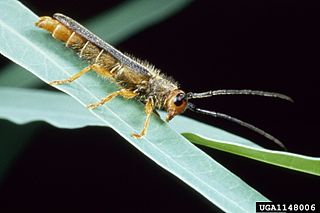
The leafy spurge stem boring beetle, also known as the red-headed leafy spurge stem borer is a species of longhorn beetle that is a biological control agent for leafy spurge. It is an effective killer of the pest but only works on certain strains of leafy spurge, namely the subgenus Esula of the genus Euphorbia. Because of this, the beetle is considered as secondary in leafy spurge control to five species of Aphthona flea beetle.
The Sumac stem borer, also known as Oberea ocellata, is a species of flat-faced longhorn beetle in the tribe Saperdini in the genus Oberea, discovered by Haldeman. It is a notable pest of trees and can cause serious damage if not stopped.

Xylosandrus compactus is a species of ambrosia beetle. Common names for this beetle include black twig borer, black coffee borer, black coffee twig borer and tea stem borer. The adult beetle is dark brown or black and inconspicuous; it bores into a twig of a host plant and lays its eggs, and the larvae create further tunnels through the plant tissues. These beetles are agricultural pests that damage the shoots of such crops as coffee, tea, cocoa and avocado.
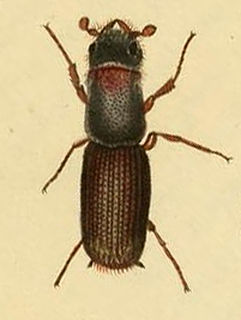
Platypus cylindrus, commonly known as the oak pinhole borer, is a species of ambrosia beetle in the weevil family Curculionidae. The adults and larvae burrow under the bark of mature oak trees. It is native to Europe.

The lemon tree borer, also known as the whistling beetle or the singing beetle, is a longhorn beetle endemic to New Zealand. Its larvae are generalist feeders, boring into the wood of a wide variety of trees, native and introduced. When citrus orchards were first established in New Zealand, this beetle started inflicting serious damage, and so gained the name "lemon tree borer". Four species within the genus Oemona have been identified, suggesting that more species could be found. When disturbed by predators or humans, the adult beetle stridulates creating a "rasp" or "squeak" sound by rubbing its thorax and head together against an area of thin ridges. Māori would eat a liquid called "pia manuka", which was produced by manuka trees when its wood was damaged by the larva. When Captain Cook first arrived in NZ, his naturalists, Banks and Solander, collected a lemon tree borer in their first collection between 1769-1771. This oldest collected specimen can be found in the British Museum. A few years after the first collection, the species would be first described by a Danish naturalist, called Fabricius, in 1775.



















